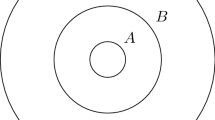Abstract
Parallelism has been drawn between modes of representation and problem-sloving processes: Diagrams are more useful for brainstorming while symbolic representation is more welcomed in a formal proof. The paper gets to the root of this clear-cut dualistic picture and argues that the strength of diagrammatic reasoning in the brainstorming process does not have to be abandoned at the stage of proof, but instead should be appreciated and could be preserved in mathematical proofs.
Similar content being viewed by others
References
Anderson, M., Cheng, P., Haarslev, V. (eds) (2000) Theory and application of diagrams. Springer, Berlin
Barwise, J., Allwein, G. (eds) (1996) Logical reasoning with diagrams. Oxford University Press, New York
Barwise J., Etchemendy J. (1989) Information, infons and inference. In: Cooper R., Mukai K., Perry J. (eds) Situation theory and its applications I. Center for the Study of Language and Information, Stanford, CA, pp 33–78
Barwise J., Hammer E. (1994) Diagrams and the concept of logical system. In: Gabbay D. M. (eds) What is a logical system?. Oxford University Press, New York
Berkeley, G. (1920). [1776]. A treatise concerning the principles of human knowledge. Chicago: Open Court.
Boolos, G., Jeffrey, R. (1989). [1974]. Computability and logic Cambridge, UK: Cambridge University Press.
Heath, T. (Ed.), (1956) The thirteen books of Euclid’s elements. Dover Publications, New York
Hilbert, D. (1971). The foundations of geometry (L. Unger, Trans. and P. Bernays, Revised). Chicago: Open Court.
Kant, I. (1929). Critique of pure reason (N. K. Smith, Trans.). London: Macmillan Press.
Locke J. (1924). [1737]. Essay concerning human understanding. Oxford: Clarendon Press.
Mancosu, P., Jørgensen, K. F., Pedersen, S. A. (eds) (2005) Visualization, explanations and reasoning styles in mathematics. Springer, Dordrecht
Peirce, C. S. (1933). In C. Hartshorne & P. Weiss (Eds.), Collected papers of Charles Sanders Peirce (Vol. 3). Cambridge, MA: Harvard University Press.
Polya, G. (1973). [1945]. How to solve it: A new aspect of mathematical method. Princeton, NJ: Princeton University Press.
Shimojima A. (1996) Operational constraints in diagrammatic reasoning. In: Barwise J., Allwein G. (eds) Logical reasoning with diagrams. Oxford University Press, New York, pp 27–48
Shin S.-J. (1994) The logical status of diagrams. Cambridge University Press, New York
Shin S.-J. (1997) Kant’s syntheticity revisited by Peirce. Synthese, 113: 1–41
Shin S.-J. (2002) The iconic logic of Peirce’s graphs. MIT Press (Bradford), Cambridge, MA
Shin, S.-J. (2010). Peirce’s two ways of abstraction. In M. Moore (Ed.), Charles S. Peirce’s philosophy of mathematics (pp. 23–40). Chicago: Open Court (forthcoming).
Author information
Authors and Affiliations
Corresponding author
Rights and permissions
About this article
Cite this article
Shin, SJ. The forgotten individual: diagrammatic reasoning in mathematics. Synthese 186, 149–168 (2012). https://doi.org/10.1007/s11229-012-0075-1
Received:
Accepted:
Published:
Issue Date:
DOI: https://doi.org/10.1007/s11229-012-0075-1




